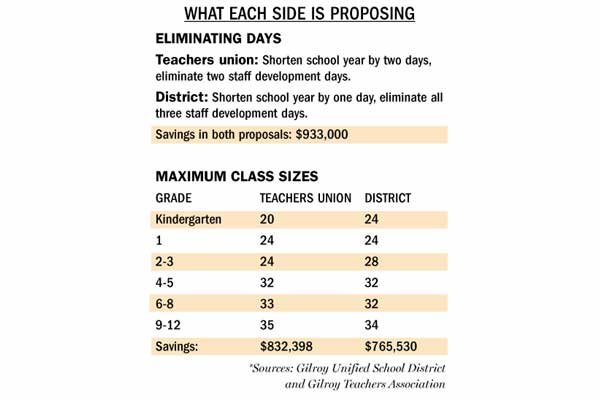After weeks of butting heads over class sizes and the length of
the school year, the school district and teachers union reached a
stalemate this week.
After weeks of butting heads over class sizes and the length of the school year, the school district and teachers union reached a stalemate this week.
The Gilroy Unified School District declared impasse Monday after failing to reach agreement with the Gilroy Teachers Association, which represents about 585 teachers, over the course of multiple negotiating sessions. Major sticking points included boosting class sizes at the lower grades and shortening the school year.
“Although we’ve moved closer to each other, we still have a long ways to go,” said Superintendent Deborah Flores, who has only experienced one other impasse in her career.
As part of a $6.3 million budget reduction forced upon the school district by the state, the school board approved as a worst case scenario increasing class sizes to 28 in kindergarten through third grades, 34 in fourth through eighth grades and 36 in ninth through 12th grades. The board also sent out 40 corresponding layoff notices earlier this year. However, changes in class sizes must be negotiated with the union, and both the union and district want smaller class sizes.
The district originally proposed cutting all three staff development days from the teachers’ calendar to save about $700,000, with no guarantee that those days would be brought back after the budget climate improved, GTA President Michelle Nelson said. The teachers countered with a proposal to take four furlough days – the equivalent of about a 2 percent pay cut – in exchange for keeping staff development. The move would save about $933,000, which could go toward keeping class sizes lower and, in turn, saving jobs, Nelson said.
After several meetings, the district still wanted to eliminate all three staff development days but also added one school day to the chopping block, for $933,000 in savings. However, the union balked, agreeing only to split the four furlough days evenly – “two student days, two staff development days,” Nelson said.
As for class sizes, the union’s proposal tends to offer smaller class sizes in lower grades and larger classes in higher grades.
The union’s class size proposal saves about $67,000 more than the district’s and the union asked that that money be put toward teacher benefits, a request the district denied, Nelson said.
By declaring impasse, the district will trigger the involvement of a mediator assigned to the case by the California Public Employment Relations Board.
Confident that the mediator would rule in the district’s favor on the issue of class sizes, trustee Denise Apuzzo pointed out how many school districts have increased lower grade level classes to as many as 30 students per class.
Packing nearly 40 high school students into a classroom while maintaining class sizes of only 20 students in kindergarten is “just not fair,” Apuzzo said.
“They’re trying to save (class sizes of) 20 in kindergarten on the backs of our secondary students,” she said. “Every time the secondary grade levels inch up even a little bit, it makes it possible to go even beyond 40 students per class.”
At middle and high schools, student-to-teacher ratios are used for staffing purposes and do not guarantee a limit. Nelson said the district could make a bigger impact on the upper grades by capping class sizes. But capping class sizes at the high school is difficult with the variety of courses offered at the upper grades, Flores said. For example, if 37 students want to enroll in an Advanced Placement class, the high school doesn’t have the staff to offer two separate classes for that course, she explained.
In previous years, the district worked to maintain lower class sizes while increasing ratios at the middle and high school, Flores said. Additionally, the district cut an entire period from the middle school day two years ago. And since many of the kindergarten through third grade class have 21 or 22 students already, adding another two or three is “a modest increase,” Flores said.
“I think our proposal is very reasonable,” she said. “It leaves fourth through 12th grade alone. The impacts on the middle and high schools in the past few years have been tremendous and we’re trying to balance.”
Maintaining class sizes at the middle and high schools is an equity issue, trustees said.
“Those classes are already huge,” trustee Fred Tovar said. “I just can’t see us going any higher.”
While some districts throughout the county have imposed furlough days on their teachers, cutting the school year by as many as five days, Gilroy trustees said they were in favor of more, not fewer, school days.
“We don’t want to give up any days because every day is of value,” trustee Francisco Dominguez said. “When you start eating away at instructional time, you’re really taking away from education and we don’t want that to happen.”
Flores agreed.
“Our commitment has always been to keep 180 days,” she said. “Even that isn’t enough to accomplish all the things we need to accomplish.”
But as long at the cuts to the school year were temporary, teachers would be able to adjust, Nelson said.
“The quality of instruction of 176 days with lower class sizes will be better than 180 days with higher class sizes,” Nelson said earlier this year.
Plus, staff development days are an integral part of achieving district goals, she said. Although the district proposed cutting the three days dedicated solely to staff development, district administrators would work that training into the school year, Flores said.
Although Flores said she felt the district had approached the negotiations in good faith, Nelson said that the district’s last proposal – entitled “Last, Best and Final Offer,” according to Nelson – wasn’t enough of a compromise.
“Negotiations are supposed to be a give and take, and all they’re willing to do is take,” Nelson said.
The school district and teachers union will again meet to negotiate Monday.















